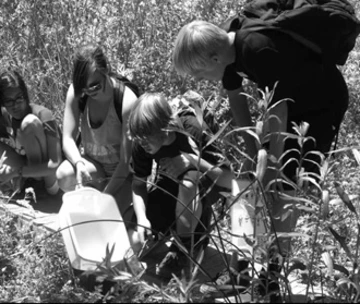Back to Summer 2012 Newsletter
by Kerry Schwartz, Holly Thomas-Hilburn and Candice Rupprecht, WRRC Arizona Project WET

Students gather to inventory plant and animal diversity as part of WIP’s interactive Riparian Areas and Biodiversity Unit. Source: Arizona Project WET.
Imagine middle school students calculating water use at their school, faucet by faucet; and then installing water saving technology. Then imagine a team of student scientists, studying river macroinvertebrates or mapping the locations of animal tracks or laying out transects to inventory plant species, all in a pristine riparian setting. If you can imagine this, you will be imagining how real students in Arizona schools were spending their time last school year in Arizona Project WET’s Water Investigations Program (WIP).
These experiences define educational best practices: hands-on, student-driven questions, real data, relevance and purpose. WIP represents a new full-year approach to modeling these practices for teacher professional development. Their middle school students benefit from the program by learning about urban water use and riparian systems through a year-long exploration. The WIP was piloted in 2010-2011 with five teachers, thanks to a small Arizona
Department of Environmental Quality grant. Students from these classes conducted their investigations at The Nature Conservancy’s San Pedro River and Three Links Farm Preserves.
The Nature Conservancy of Arizona became a full partner in 2011, and the Program expanded to the Phoenix Valley. Nineteen teachers were recruited for the 2011-2012 school year. These teachers participated in a three-day summer academy, followed by three more training days over the school year. By the end of the year more than 1,800 students had taken part in the WIP. In the coming year, 1,900 more students are slated to join the ranks of Water Investigators in their communities.
The approach is interdisciplinary. In the 2011-2012 school year students learned about the natural systems within the larger hydrologic cycle as well as the human constructed water distribution system. They also explored the connections between urban water use and the water in Arizona’s rivers and riparian systems.
A 2011 Gallup poll shows that water issues are Americans’ top environmental concern, however a recent Nature Conservancy study found that 75 precent of adults cannot identify where their water comes from when asked. Filling that gap – helping youth and their families understand where their water comes from – is afocal point of Arizona Project WET’s WIP.
The WIP is incorporated into students’ existing curriculum over an entire year. Students can dig deeply into the study of water through projects that integrate all subject areas. WIP students work their way through three thematic units, starting with the Water Resources & Supply Unit, which focuses on understanding Arizona’s natural systems and the urban water distribution system. Lessons are interactive and employ physical models.
Water Use is the second thematic unit. This is the unit in which the students take part in a water audit of their school. The exercise of performing the audit themselves teaches good scientific practice. This unit provides a fundamental understanding of all the ways water is used in daily life and challenges students to ask questions and propose solutions to conserve water.
Stepping through a program of scientific investigation, students first measured faucet flow at bathroom faucets and identified what else they would need to know to figure out thenumber of gallons used in the school bathrooms in a year. They then designed a scientific procedure to determine the frequency and duration of faucet use in the school. The math curriculum was brought into play in order for students to quantify the water use. After making that calculation, they installed faucet aerators, measured the flow again, and recalculated the water use. An aerator lowers the amount of water coming out of a faucet each minute by mixing in air. By knowing the before and after numbers, the students were able to calculate water savings. Finally, students taught their parents to audit their bathroom faucets at home and install water efficient aerators that save their families water and money. The school and home water audits in Maricopa County resulted in an annual water savings of 10.3 million gallons from the installation of 2,075 aerators.
The WIP concludes with the Riparian Areas and Biodiversity Unit. The high point of this unit is a field study in a local riparianarea or preserve. After a year of learning to develop testable questions, students are challenged to design and conduct their own riparian area investigations. Students developed questions on a wide range of topics, from testing water quality parameters to inventorying plant and animal species diversity. The scale of this activity was tremendous. On 14 different days, 1,500 of these students visited the Hassayampa River Preserve. There they conducted their own investigations, with mentor scientists from the University of Arizona and Prescott College on hand to facilitate learning.
The WIP culminates with a Student Symposium at a local Community College or University. Just as at a scientific conference, students deliver Prezi or Power Point presentations to What discovery or insight did you make about the Hassayampa River? What is your interest in STEM fields? Hassayampa Field Day Assessment For comparison, 10.7% of all degrees awarded in 2008-2009 were in STEM fields. Name some technological and some behavioral ways to save water. peers, teachers and community members. T
he Student Symposium for the 2010-2011 WIP was held at the University of Arizona for 200 students. At the end of the 2011- 2012 WIP, Phoenix College hosted 300 students who gave over 50 presentations and nearly 300 additional students participated in symposium events at their schools.
Kerry Schwartz, APW Director, looks on the WIP as a model of effective water education, “WIP students are learning to make a difference in their communities. They’re becoming interested in investigating scientific questions and engineering solutions. They’re getting comfortable with thinking critically about complex issues. Students like these are Arizona’s future.”

